Sharing a poem every day adds a pause for thoughtfulness on an individual level or for an entire classroom. Poetry can offer insight into every aspect of life, from sadness to bliss, from fear to courage, and from loneliness to companionship. Delve into the poetry in the books listed below and share this poetry with students to create an environment for words used in imaginative ways.
Ages 4–8
All Year Round. Susan B. Katz. Ill. Eiko Ojala. 2016. Orchard/Scholastic.
 “A world of shapes / TWELVE MONTHS abound, / from four-cornered square, / to circle, round.” The opening poem sets the style and theme for this picture book that takes young readers through the calendar year. Colorful digital illustrations feature a young, red-haired boy and an olive-skinned, dark-haired girl who take readers on a romp through the year. Watch for the black-and-white spotted dog on each two-page spread, adding to the fun of each month’s activity. A different shape is featured for each month. Circles become a snowman in January, a heart (of course!) is cut from paper in February, the hatching of oval eggs occurs in March, a half-circle rainbow appears in April, and so on. The rhyming text and brightly colored cartoon-like illustrations make this a good read-aloud choice for introducing young children to the concepts of shapes and months of the year.
“A world of shapes / TWELVE MONTHS abound, / from four-cornered square, / to circle, round.” The opening poem sets the style and theme for this picture book that takes young readers through the calendar year. Colorful digital illustrations feature a young, red-haired boy and an olive-skinned, dark-haired girl who take readers on a romp through the year. Watch for the black-and-white spotted dog on each two-page spread, adding to the fun of each month’s activity. A different shape is featured for each month. Circles become a snowman in January, a heart (of course!) is cut from paper in February, the hatching of oval eggs occurs in March, a half-circle rainbow appears in April, and so on. The rhyming text and brightly colored cartoon-like illustrations make this a good read-aloud choice for introducing young children to the concepts of shapes and months of the year.
Before Morning. Joyce Sidman. Ill. Beth Krommes. 2016. Houghton Mifflin Harcourt.
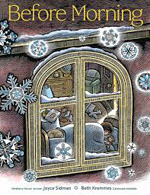 The award-winning duo of Sidman and Krommes unite again to create this poetic picture book of a young child’s bedtime wish for snow before morning. Krommes’s signature scratchboard artwork begins on wordless pages. A mother and child walk their dog in the city, then return home to warmth and dinner on the table. The young girl appears to be sad. Mother changes into her pilot’s uniform as the young girl hides her cap. While the girl sleeps, Mother leaves the house as heavy snow falls. At the airport, she learns that flights are delayed and planes grounded. Catching a ride with a snowplow driver, she arrives home to the joy of her daughter. While Krommes carries the action of the story through illustration as the snow piles deeper and deeper, Sidman evokes the feelings of the child and her wishful thinking in a quiet, lyrical text: “In the deep woolen dark, / as we slumber unknowing, / let the sky fill with flurry and flight.”
The award-winning duo of Sidman and Krommes unite again to create this poetic picture book of a young child’s bedtime wish for snow before morning. Krommes’s signature scratchboard artwork begins on wordless pages. A mother and child walk their dog in the city, then return home to warmth and dinner on the table. The young girl appears to be sad. Mother changes into her pilot’s uniform as the young girl hides her cap. While the girl sleeps, Mother leaves the house as heavy snow falls. At the airport, she learns that flights are delayed and planes grounded. Catching a ride with a snowplow driver, she arrives home to the joy of her daughter. While Krommes carries the action of the story through illustration as the snow piles deeper and deeper, Sidman evokes the feelings of the child and her wishful thinking in a quiet, lyrical text: “In the deep woolen dark, / as we slumber unknowing, / let the sky fill with flurry and flight.”
Miss Muffet, or What Came After. Marilyn Singer. Ill. David Litchfield. 2016. Clarion/Houghton Mifflin Harcourt.
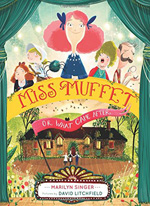 Singer puts a new spin on an old nursery rhyme in this zany tale about Miss Muffet. Starting with the traditional verse about this tuffet-sitter and a certain spider, the playful rhyming story takes off as a play complete with stage directions and costume changes. An offstage narrator tells the story while a modern Miss Patience Muffet and Webster the spider run off together and encounter other nursery rhyme characters. When Miss Muffet and her new companion, Bo Peep, discover that Old King Cole needs new fiddlers, they assemble a trio and head to the castle. As the subtitle hints, Miss Muffet and other characters that “come after” give the story of Old King Cole a satisfying ending. The mixed-media illustrations provide the backdrop for this theatrical story with period costumes and settings. With its narrator, dialogue of characters in speech bubbles, and the chorus of a trio of minor characters commenting in unison on the action, this drama in verse begs to be performed.
Singer puts a new spin on an old nursery rhyme in this zany tale about Miss Muffet. Starting with the traditional verse about this tuffet-sitter and a certain spider, the playful rhyming story takes off as a play complete with stage directions and costume changes. An offstage narrator tells the story while a modern Miss Patience Muffet and Webster the spider run off together and encounter other nursery rhyme characters. When Miss Muffet and her new companion, Bo Peep, discover that Old King Cole needs new fiddlers, they assemble a trio and head to the castle. As the subtitle hints, Miss Muffet and other characters that “come after” give the story of Old King Cole a satisfying ending. The mixed-media illustrations provide the backdrop for this theatrical story with period costumes and settings. With its narrator, dialogue of characters in speech bubbles, and the chorus of a trio of minor characters commenting in unison on the action, this drama in verse begs to be performed.
Mommy Goose: Rhymes From the Mountains. Mike Norris. Ill. Minnie Adkins. 2016. University of Kentucky Press.
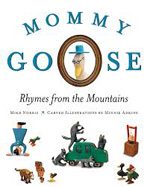 Mommy Goose, illustrated with photographs of the charming carved images of folk artist Minnie Adkins, is a collection of 50 original nursery rhymes inspired by traditional rhymes recited and sung by children of Appalachia. Norris’s verses reflect the language of the region: “Crack, crack, crack. / The hammer said that / As he hit the nail three times. / The nail said, ‘Oww, / You’re in trouble now. / I’ll law you for this crime.’” Children will enjoy the humor of these silly verses about raccoons, Old Doc Hale, calico cats, and more; adults will appreciate Mommy Goose as an important collection of regional oral folk traditions.
Mommy Goose, illustrated with photographs of the charming carved images of folk artist Minnie Adkins, is a collection of 50 original nursery rhymes inspired by traditional rhymes recited and sung by children of Appalachia. Norris’s verses reflect the language of the region: “Crack, crack, crack. / The hammer said that / As he hit the nail three times. / The nail said, ‘Oww, / You’re in trouble now. / I’ll law you for this crime.’” Children will enjoy the humor of these silly verses about raccoons, Old Doc Hale, calico cats, and more; adults will appreciate Mommy Goose as an important collection of regional oral folk traditions.
Ages 9–11
The Alligator’s Smile and Other Poems. Jane Yolen. Photography, Jason Stemple. 2016. Millbrook/Lerner.
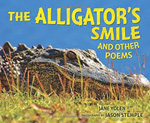 “Silently floating, / Silently gloating, / Not a log.” It’s an alligator! In this everything-you-wanted-to-know-about-alligators book of poems, Jane Yolen and photographer Jason Stemple bring readers up close and personal with alligators. Yolen’s clever poems, written in various poetic forms, introduce facts about alligators, while Stemple’s stunning two-page spread photographs provide views of these reptiles in their natural environment. Through the poetry, readers learn all about alligators, from babies to dinosaur-like adults, including their history, life cycles, eating habits, and habitat. Related facts about alligators are framed in green boxes surrounded by sharp teeth-like borders. Back matter includes additional information about alligators and their habitats, a glossary, and resources (websites and books).
“Silently floating, / Silently gloating, / Not a log.” It’s an alligator! In this everything-you-wanted-to-know-about-alligators book of poems, Jane Yolen and photographer Jason Stemple bring readers up close and personal with alligators. Yolen’s clever poems, written in various poetic forms, introduce facts about alligators, while Stemple’s stunning two-page spread photographs provide views of these reptiles in their natural environment. Through the poetry, readers learn all about alligators, from babies to dinosaur-like adults, including their history, life cycles, eating habits, and habitat. Related facts about alligators are framed in green boxes surrounded by sharp teeth-like borders. Back matter includes additional information about alligators and their habitats, a glossary, and resources (websites and books).
One Today. Richard Blanco. Ill. Dav Pilkey. 2015. Little, Brown.
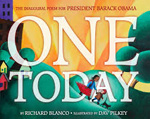 After President Barack Obama was sworn into office for his second inauguration on Jan. 21, 2013, at 11:55 a.m., in front of an estimated 1,000,000 people gathered on the National Mall, “Richard Blanco ascended the podium and read this poem, which he wrote to mark the occasion.” The poem is about America. It follows the light of the sun as it moves across the country, shedding the glow of life in the United States. Pilkey’s illustrations, rendered in acrylics and India ink, provide a colorfully vibrant background that represents the journey of this poem across the nation. Two children—one white, one black—are featured as they move with their black cat through their day’s activities before returning home again. This beautiful commemorative poem, made accessible to children through Pilkey’s visual interpretation, captures the hearts of readers of all ages.
After President Barack Obama was sworn into office for his second inauguration on Jan. 21, 2013, at 11:55 a.m., in front of an estimated 1,000,000 people gathered on the National Mall, “Richard Blanco ascended the podium and read this poem, which he wrote to mark the occasion.” The poem is about America. It follows the light of the sun as it moves across the country, shedding the glow of life in the United States. Pilkey’s illustrations, rendered in acrylics and India ink, provide a colorfully vibrant background that represents the journey of this poem across the nation. Two children—one white, one black—are featured as they move with their black cat through their day’s activities before returning home again. This beautiful commemorative poem, made accessible to children through Pilkey’s visual interpretation, captures the hearts of readers of all ages.
The White Cat and the Monk: A Retelling of the Poem “Pangur Bán.” Jo Ellen Bogart. Ill. Sydney Smith. 2016. Groundwood/House of Anansi.
 Beginning with panels of watercolor-and-ink paintings on wordless pages, Smith sets the scene for this tale from the Middle Ages as a white cat prowls the halls of a monastery and makes its way into a monk’s cell. Based on an old Irish poem, “Pangur Bán”, Bogart’s retelling is the story of a Benedictine monk, a scholar who compares his solitary life and work to that of the cat. Together, the spare, lyrical text and expressive illustrations offer a quiet and comforting story of companionship. “We are each content, with all we need to entertain us. Ours is a happy tale.” An author’s note provides background information for this retelling of “Pangur Bán”.
Beginning with panels of watercolor-and-ink paintings on wordless pages, Smith sets the scene for this tale from the Middle Ages as a white cat prowls the halls of a monastery and makes its way into a monk’s cell. Based on an old Irish poem, “Pangur Bán”, Bogart’s retelling is the story of a Benedictine monk, a scholar who compares his solitary life and work to that of the cat. Together, the spare, lyrical text and expressive illustrations offer a quiet and comforting story of companionship. “We are each content, with all we need to entertain us. Ours is a happy tale.” An author’s note provides background information for this retelling of “Pangur Bán”.
Ages 12–14
Lion Island: Cuba’s Warrior of Words. Margarita Engle. 2016. Atheneum/Simon & Schuster.
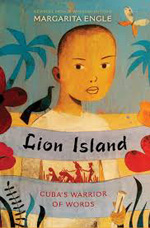 Once again, award-winning author Margarita Engle reaches back into the annals of Cuban history to introduce readers to another hero of civil rights. In her signature verse novel style, Engle brings the story of Antonio Chuffat to the pages of Lion Island. In the late 1800s, young Chuffat, who was of mixed African, Chinese, and Cuban descent, works as a messenger where his mixed cultural background works to his advantage. He witnesses the forced labor practices of the indentured Chinese workers, and during this time becomes friends with Wing and Fin, Chinese Americans who have escaped the race riots in San Francisco. Together, these young people seek ways to help and report the plight of the enslaved workers. When the Chinese government learns about the horrific treatment of their people, Antonio Chufatt becomes a recorder of the stories and atrocities happening on his island. He has become “Cuba’s Warrior of Words.”
Once again, award-winning author Margarita Engle reaches back into the annals of Cuban history to introduce readers to another hero of civil rights. In her signature verse novel style, Engle brings the story of Antonio Chuffat to the pages of Lion Island. In the late 1800s, young Chuffat, who was of mixed African, Chinese, and Cuban descent, works as a messenger where his mixed cultural background works to his advantage. He witnesses the forced labor practices of the indentured Chinese workers, and during this time becomes friends with Wing and Fin, Chinese Americans who have escaped the race riots in San Francisco. Together, these young people seek ways to help and report the plight of the enslaved workers. When the Chinese government learns about the horrific treatment of their people, Antonio Chufatt becomes a recorder of the stories and atrocities happening on his island. He has become “Cuba’s Warrior of Words.”
The Lonely Ones. Kelsey Sutton. 2016. Philomel/Penguin.
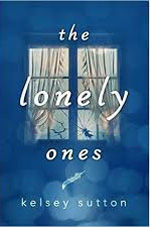 Fain Fredericks’s life is falling apart. Her family’s financial crisis during the recession has left them in turmoil, and to make matters worse, her best friend moved away without a word. Fain is becoming invisible to all those around her at both school and home. At night, she begins to create a fantasy world where she can escape and journey with creatures that she rules as their queen. During the day, she spirits away to a local quarry, where she can hide out and write about her fantasy world in solitude. Sutton’s well-crafted free-verse poems chronicle Fain’s life as she withdraws from everything and then begins to consider the tenuous promise of a brighter tomorrow when a favorite teacher enters one of her stories in a contest and new friendships seem possible. As Fain’s life begins to change and positive things offer a glimmer of hope, she is confronted with leaving her beloved imaginary world behind.
Fain Fredericks’s life is falling apart. Her family’s financial crisis during the recession has left them in turmoil, and to make matters worse, her best friend moved away without a word. Fain is becoming invisible to all those around her at both school and home. At night, she begins to create a fantasy world where she can escape and journey with creatures that she rules as their queen. During the day, she spirits away to a local quarry, where she can hide out and write about her fantasy world in solitude. Sutton’s well-crafted free-verse poems chronicle Fain’s life as she withdraws from everything and then begins to consider the tenuous promise of a brighter tomorrow when a favorite teacher enters one of her stories in a contest and new friendships seem possible. As Fain’s life begins to change and positive things offer a glimmer of hope, she is confronted with leaving her beloved imaginary world behind.
Somos como las nubes=We Are Like the Clouds. Jorge Argueta. Trans. Elisa Amado. Ill. Alfonso Ruano. 2016. Groundwood/House of Anansi.
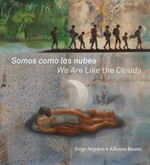 Over 100,000 children have left Central America to find a new and safer place to live. Jorge Argueta, a refugee from El Salvador, creates poems that explain what it is like for these children to leave behind everything they have known and grown up with, often including their families. The poems, in both Spanish and English, speak to the dangers and hardships these children experience on their journeys before they arrive at the borders of the United States. Alfonso Ruano’s darkly shaded acrylic artwork creates a somber mood for their dangerous treks made with hope for a better life.
Over 100,000 children have left Central America to find a new and safer place to live. Jorge Argueta, a refugee from El Salvador, creates poems that explain what it is like for these children to leave behind everything they have known and grown up with, often including their families. The poems, in both Spanish and English, speak to the dangers and hardships these children experience on their journeys before they arrive at the borders of the United States. Alfonso Ruano’s darkly shaded acrylic artwork creates a somber mood for their dangerous treks made with hope for a better life.
Ages 15+
Leave This Song Behind: Teen Poetry at Its Best. Stephanie H. Meyer, John Meyer, Adam Halwitz, and Cindy W. Spertner (Eds.). 2016. Teen Talk/Health Communications.
 This anthology includes the poetry written by teenage writers who have submitted their poems to Teen Ink over the last five years. The poems vary from serious and deep thinking to light-hearted and spirited approaches to life. After the foreword by Todd Strasser, this slim volume is divided into seven thematic sections: “Come to Your Senses,” “Less Is More,” “Get Into Shape,” “Let Me Tell You a Story,” “Shall I Compare Thee to…?,” “I Wasn’t Expecting That,” and “Love, Life, Death (and other overwritten themes).” Back matter includes notes from each of the teens, an index, and a permissions section.
This anthology includes the poetry written by teenage writers who have submitted their poems to Teen Ink over the last five years. The poems vary from serious and deep thinking to light-hearted and spirited approaches to life. After the foreword by Todd Strasser, this slim volume is divided into seven thematic sections: “Come to Your Senses,” “Less Is More,” “Get Into Shape,” “Let Me Tell You a Story,” “Shall I Compare Thee to…?,” “I Wasn’t Expecting That,” and “Love, Life, Death (and other overwritten themes).” Back matter includes notes from each of the teens, an index, and a permissions section.
Up From the Sea. Leza Lowitz. 2016. Crown/Random House.
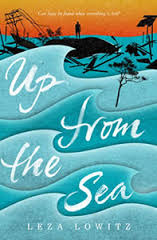 Set in March 2011 during the horrific earthquake and tsunami that hit Japan, this novel in verse is contemporary fiction based on actual events at its best. The story is told through the voice of Kai, a 17-year-old biracial boy living in a small coastal village in the Tohoku region of Japan. The author includes many scenes from the tsunami within the story and adds notes at the end of the book to further discuss this natural disaster. Her free verse and concrete poems create vivid images of the turbulent weather and subsequent devastation. During the storm, Kai loses all the members of his existing family. In the aftermath, a grieving Kai receives an opportunity to go to America and look for his American father, who left the family years earlier. While in New York, Kai is introduced to young people who lost their parents in the 9/11 terrorist attacks. This shared experience of tragedy and survival helps Kai to move forward through his grief and begin to carve out a new life for himself upon returning to Japan.
Set in March 2011 during the horrific earthquake and tsunami that hit Japan, this novel in verse is contemporary fiction based on actual events at its best. The story is told through the voice of Kai, a 17-year-old biracial boy living in a small coastal village in the Tohoku region of Japan. The author includes many scenes from the tsunami within the story and adds notes at the end of the book to further discuss this natural disaster. Her free verse and concrete poems create vivid images of the turbulent weather and subsequent devastation. During the storm, Kai loses all the members of his existing family. In the aftermath, a grieving Kai receives an opportunity to go to America and look for his American father, who left the family years earlier. While in New York, Kai is introduced to young people who lost their parents in the 9/11 terrorist attacks. This shared experience of tragedy and survival helps Kai to move forward through his grief and begin to carve out a new life for himself upon returning to Japan.
Karen Hildebrand is a retired/rewired school librarian and is active in NCTE and ILA. She is part of the Teacher Fellowship program at the Holocaust Memorial Museum in Washington, D.C. and serves as the Education Curriculum Chair of the Delaware County Historical Society in Ohio. She currently serves as the chair of the NCTE Award for Excellence in Children’s Poetry and recently served on the Notable Trade Books in the Social Studies committee.
These reviews are submitted by members of the International Literacy Association's Children's Literature and Reading Special Interest Group (CL/R SIG) and are published weekly on Literacy Daily.